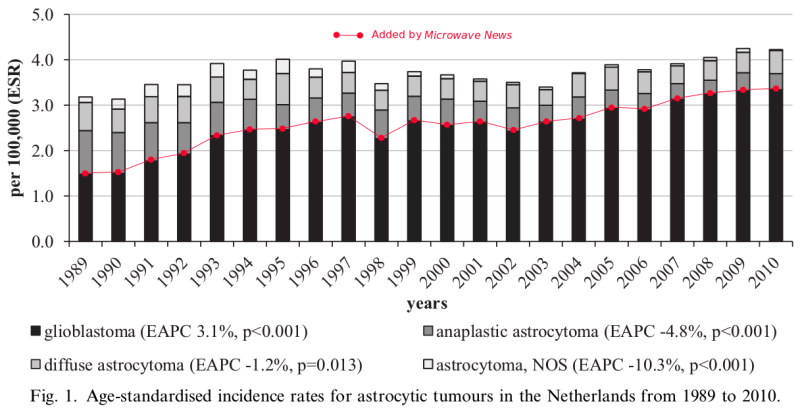The issue of whether brain tumor rates are rising or not is much more complicated than observing a total number of brain tumors to neither base a cause and effect conclusion, nor rule out scientific prevailing theory hypothesizing that wireless radiation is to blame.
Wireless trade lobbyist and their sponsored media organization want you to believe smartphones are safe based on a half-truth, yes, it is true that the overall incidence of brain tumors has not been changing much over the years, but a different picture emerges if one looks, carefully, at all types of brain tumors to examine which ones have increased dramatically within over 100 distinct types of brain tumors and central nervous system tumors.
Before we get into the location of which brain tumor incidence rates are on the rise — there is an important need to address susceptibility factors by pointing out that young children are at greater risk because of thinner skulls and cumulative effects of an entire lifetime being exposed to excessive RFR/EMF.
RF Safe issued this press release almost 2 years ago when the Brain Tumor Foundation of Canada said, “brain tumors are the leading cause of solid cancer death in children under the age of 20, now surpassing acute lymphoblastic leukemia.”
Continuing proof this global trend is now in the USA — on Feb 24, 2016 the American Brain Tumor Association issued a press release titled “Malignant Brain Tumors Most Common Cause of Cancer Deaths in Adolescents & Young Adults”
This new report published in the journal Neuro-Oncology and funded by the American Brain Tumor Association (ABTA) finds that malignant brain tumors are the most common cause of cancer-related deaths in adolescents and young adults aged 15-39 and the most common cancer occurring among 15-19 year olds.
“When analyzing data in 5-year age increments, researchers discovered that the adolescent and young adult population is not one group but rather several distinct groups that are impacted by very different tumor types as they move into adulthood,” said Elizabeth Wilson, president and CEO of the American Brain Tumor Association.
“What’s interesting is the wide variability in the types of brain tumors diagnosed within this age group which paints a much different picture than what we see in adults or in pediatric patients,” explained the study’s senior author Jill Barnholtz-Sloan, Ph.D., associate professor, Case Comprehensive Cancer Center, Case Western Reserve University School of Medicine and Scientific Principal Investigator for CBTRUS.
“For example, the most common tumor types observed in adults are meningiomas and glioblastomas (GBM), but there is much more diversity in the common tumor types observed in the adolescent and young adult population. You also clearly see a transition from predominantly non-malignant and low-grade tumors to predominantly high-grade tumors with increasing age,” Barnholtz-Sloan said.
The increase in GBMs in the temporal lobe (the region of the brain closest to the ear and potentially to a Smartphone) was seen in major cancer registries , ranging from approximately 1.3% to 2.3% per year, a finding that is statistically significant.
There is a trend occurring in the U.S., according to a team from the University of Southern California Medical School in Los Angeles. The USC researchers looked at the incidence of brain tumors in three “major cancer registries” over a 15-year period (1992-2006). In a paper published in 2012, they reported that GBMs had gone up while the other types had gone down. The study showed “decreased rates of primary brain tumors in all sites with the notable exception of increased incidence of GBM in the frontal lobes, temporal lobes and cerebellum.”
Thanks to microwavenews, the histogram below helps tell the story. It’s based on brain tumor data from The Netherlands. The black segment of each column tracks the incidence of glioblastoma multiforme (GBM), the most aggressive and deadly type of brain tumors. While the total incidence of all types of brain tumors in The Netherlands rose at the rate of only about 0.7% per year, the increase in GBM was about 3.1% per year —that is, the incidence more than doubled over the period 1989-2010. (Follow the thin red line we superimposed on the histogram to track the trend.) This is a statistically significant increase. At the same time, the rate of all the other types of brain tumors went down; these changes are also significant. The higher incidence of GBMs is being masked by the lower rates of the other types of brain cancer.

Source: Adapted by microwave news from Ho et al, European Journal of Cancer, 2014, p.231
